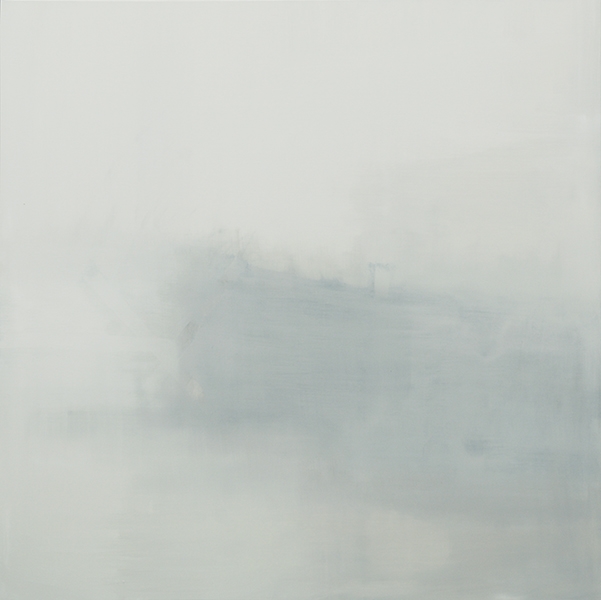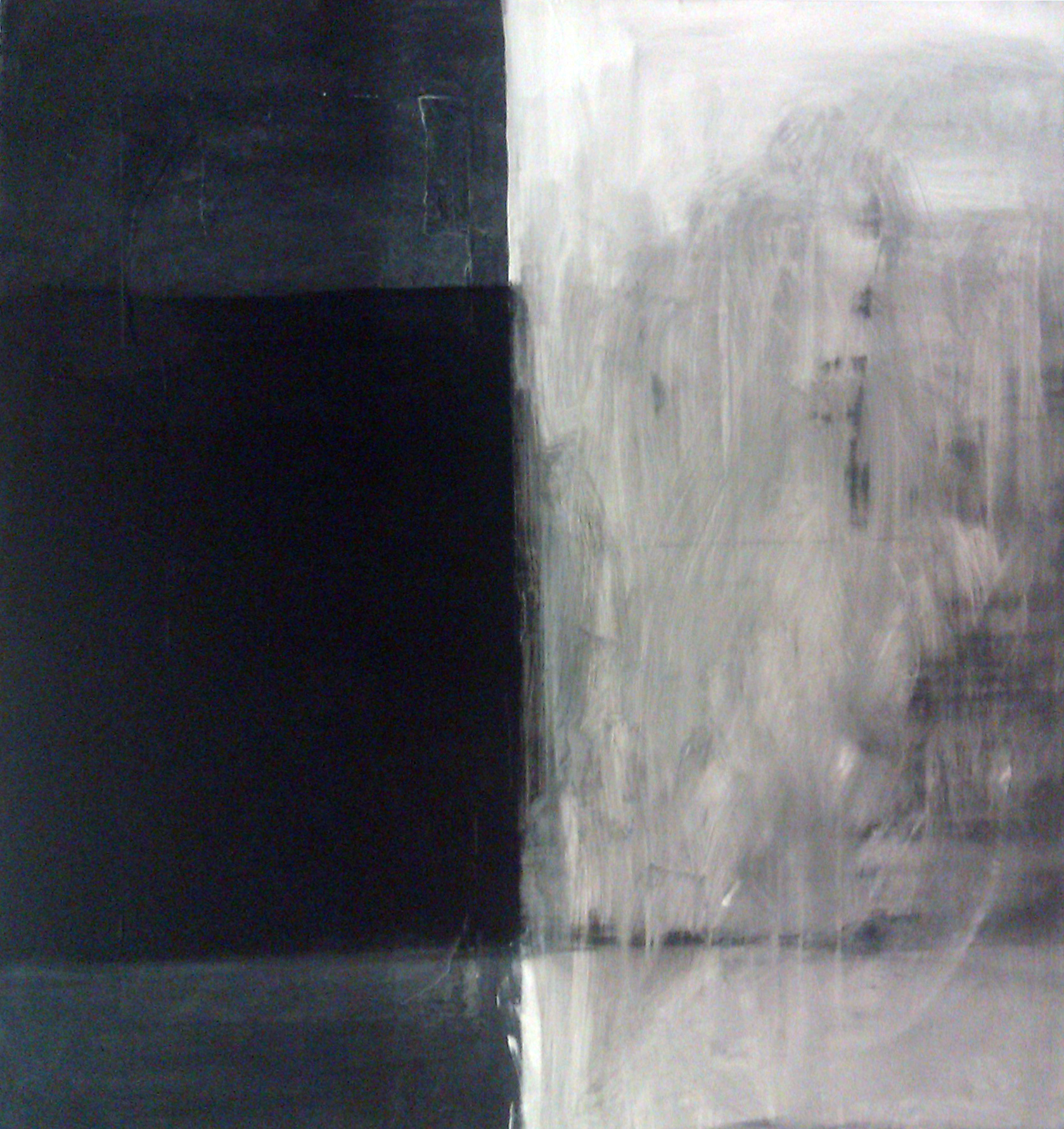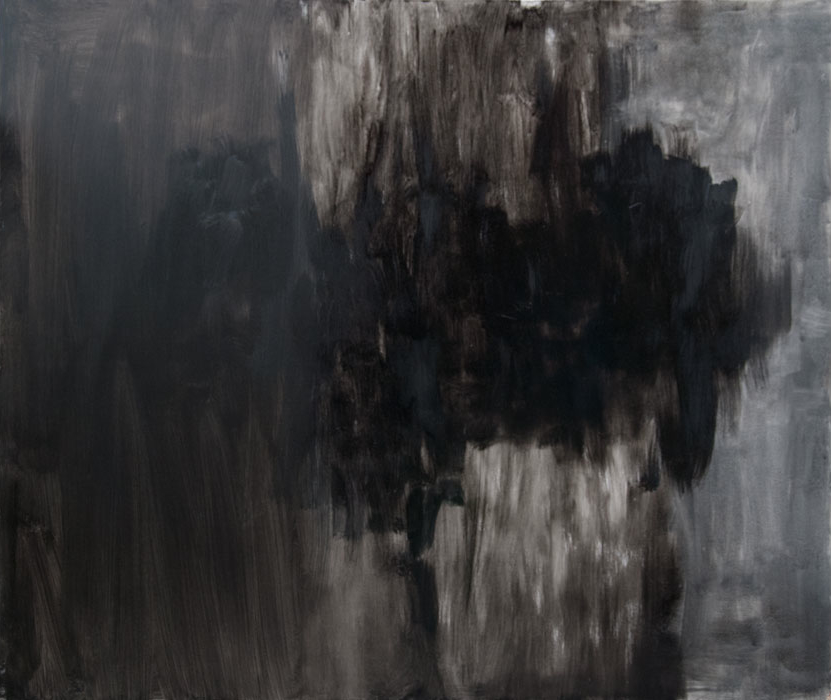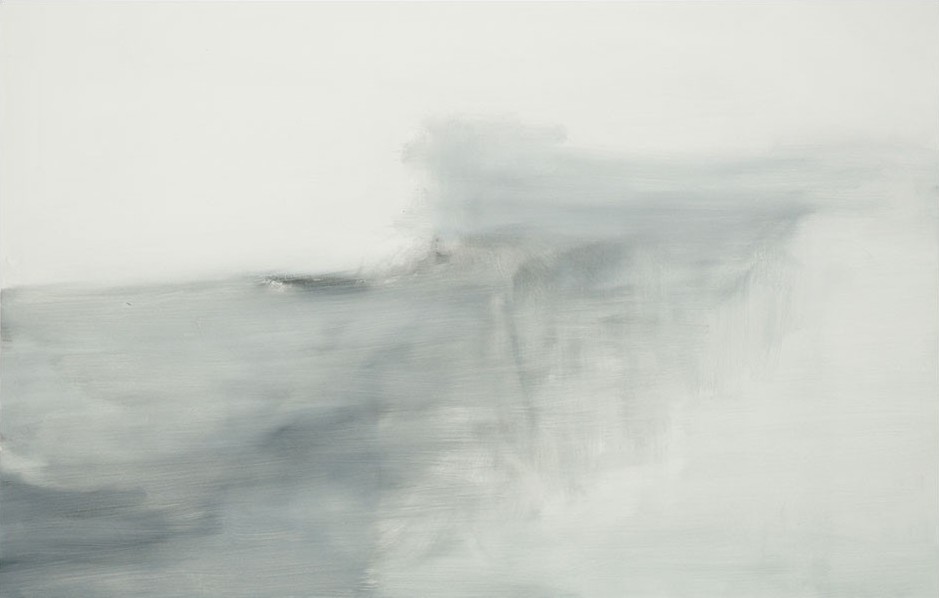
Imaginary Landscape
English
Reflections at the margin of the Michele Allegretti works by Paola Timossi
“Would come, would come a man, would come to the world a man, today, with the beard of the patriarchs: he ought to, if of this time he would speak, he ought to only mumble and mumble.”
Paul Celan
If of this time one would speak, one could aim to transform once more words in painting . The pictorial idea of Allegretti is that of making out of an image a vision , in other words detaching it from its conventional form, yielding it through a profound psychic and sensorial openness, both in the moment of its creation and in that of the expression that coincide in a sort of ideogram. Attempting this synthesis, the artist privileges the use of black and white – the zero degree of light and the sum of all the colors.
Black and white in his works contend the space, they probe one another their limits, establishing the margins of the dialogue to then break them. These opposite poles meet and mix in diverse tones, they overlap and they annul, they saturate themselves, or become transparencies maintaining rooted their clear make up, the corporeity that it embraces. They prepare the event, becoming traces that aspire to a shape but which, recognizing the conventionality, disentangle; a trace that acquires value through the elongation to the exterior, the interior of the artist.
It is the trace left by he who, looks, walks, to the gatherer: tracks, a path of which is unknown the berth. The stop in front of a landscape, across faces of men, or women, similar and unknown. It is the trace of he who observes the river running, the foliage quiver, and the transparency of a cascade; it is the waves of the sea.
As jazz music – that is composed in the act of playing – the traces of black and white do not follow one project. Yet, arranging itself on the canvas like notes on the pentagram, they reveal an image, the most intimate and hidden. Like Pollock, who does not project the painting, foreseeing instead ways of behavior: the intimate way of twisting ones own body in the rhythm of dance until the dance itself takes over the dancer and makes bloom figures and ways that it did not imagine to have. The silent rhythm of this trace, involves the physical and psychic existence of the artist.
Allegretti has traveled and picked the fruits of a dense and constant confrontation with arts, exercising and imposing discipline to his senses. Music was the encounter with the hearing and the exercise of composing, photography that with the vision and exercise of narration. His paintings are the outcome of a synthesis able to compose and deepen our sensorial capacity.
Like a journey to discovery, the scope is to reach a more profound capacity of reception and intuition, whose gift is the synthesis. In the case of Allegretti, like it has been already seen, the synthesis is separated through the choice of the achromatic white and black, capable of “requalifying” the experience translating it in an immediate language, primordial but complex.
It is the language of empathy, the language of the blind poet Homer, and of his phrases “made of wind”, a language so rich, that can not be reduced to a code, therefore so natural; it is the most difficult to learn, the easiest one to feel.
Black and white allow reaching a sensorial synthesis, the stillness of silence after the componential fury, a sort of rare suspension: the synthesis is thus formal and poetic. The corrosion of the color is the declaration of an attraction towards the incidence of the decadence in things, their frailty and their constant transformation. Subtraction is the political affirmation of the artist against the over asphyxiating trend of objects, rather the gain of a great freedom.
In all this, it is difficult to perceive only one image; more simply to recognize an eye, the gaze that sounds the invisible, the hypothesis of a landscape that becomes a path towards new dimensions.
The artist here leaves aside the picturesque language to the musical one that is able to develop less attachment to the matter that it is treating, and has a more airy capacity. It is a language that tends to not objectify its own product, camouflaging and rendering it circumscribable, less clearly decipherable.
As John Cage had made silence the fundamental reason for his musical research, for Allegretti the practice of color suspension, the vertigo of black and white, the use of erasure, of “levare”, become the space in which to submerge; the engine to the enigma, the question which repeats that request in origin that empty the canvas is. Such permits the artist to modify substantially reality: the painting that before was only an interference to the sight on a wall, taken by an almost alchemic transformation, of substance more precisely, becomes a surrounding. And if the layer of the pigments is just a millimetric film, almost inexistent, the erasure, the space willingly left unfinished or random, has the power to demand a sense. It is the element that participates to the construction of the painting, amplifying the emotional afflatus. “Subtraction” has a positive value, splendid light of miraculous state of doubt, taken as a critique to the status quo of both the accumulative and inhibited practices embodied in the contemporaneous.
With intimate coherence then, the artist prepares to a practice of subtraction of its own “me” from the finished object, the painting, alienating always from itself the psychological implications. The title and attribution of the piece, whose creation is freely put to disposition of the user, finds himself as if in a landscape entering in a natural empathic resonance to the beauty athwart, to the power emanating.
The matter becomes so sensible, becomes space; the attention of the artist is centered on real supports of the image, on the substance of things: the loom, the paper, the canvas or ink with which Allegretti confronts himself; sounding the porosity and resistance and accepting any “incident” that the matter can provoke ( a wrinkle, a stain). The casual event and the unforeseen becomes epiphany of the reality of the artistic experience that has produced the piece and sanctions a sort of completeness. The perfect finish is the certainty of the real in front of ambiguity in our affirmations and the incommutability of the most secluded sensations.
Cage speaking of his musical research, said: “I introduced silence: it was the ground, the earth, in which emptiness could grow; silence is not the absence of sound, but the involuntary action of my nervous system and circulation of my blood”. In this manifest of freedom, the body becomes for music a language to hear, a landscape to look, and the artist taken by this new take, is finally capable of operating according to nature.
Such is also for Allegretti that builds his gallery of imaginary landscape turning his interest to the state of mood with which happens the execution of the piece and through which it is perceived. To tell with the language of the blood, with the gist and movements of the face, the infinitesimal sensible layer that he is in the face of this ideal landscape called World.
As to say: would come today, would come to the world a man, today, to bring us words of silence; we ought to maybe stop mumbling and mumbling.
Paola Timossi
Italiano
Riflessioni a margine del lavoro di Michele Allegretti di Paola Timossi.
“Venisse, venisse un uomo, venisse un uomo al mondo, oggi, con la barba dei patriarchi: dovrebbe, se di questo tempo parlasse, lui dovrebbe solo balbettare e balbettare.”
Paul Celan
Se di questo tempo si volesse parlare, si potrebbe tentare di trasformare una volta ancora la parola in pittura. Lʼidea pittorica di Allegretti è quella di far dellʼimmagine una visione, ovvero allontanarla dalla sua forma convenzionale, rendendola tramite di una profonda apertura psichica e sensoriale, sia nel momento della sua ideazione che in quello dellʼespressione che vengono così a coincidere, come in una sorta di ideogramma. Tentando questa sintesi, lʼartista privilegia lʼuso del bianco e del nero – il grado zero della luce e la somma di tutti i colori.
Bianco e nero nelle sue opere si contendono lo spazio, sondano lʼun lʼaltro i propri limiti, stabiliscono i margini del discorso per poi infrangerli; incontrano e mescolano diverse tonalità, si sovrappongono e si elidono, si saturano o divengono trasparenze mantenendo salda la chiarezza compositiva, la corposità che gli è propria. Preparano lʼevento, divenendo segni che aspirano alla forma ma che, riconoscendola convenzione, se ne allontanano; un segno che assume valore in quanto prolungamento allʼesterno dellʼinteriorità dellʼartista.
Eʼ il segno lasciato da colui che, ricercando, cammina, dal raccoglitore: orme, un percorso di cui è ignoto lʼapprodo. Eʼ la sosta di fronte ad un paesaggio, davanti a volti di uomini o donne, simili e sconosciuti, è il segno di colui che osserva lo scorrere di un fiume, il fremito delle fronde, è la trasparenza di una cascata, sono le onde del mare.
Come per la musica jazz – che si compone allʼatto del suonare – questo segno non segue un progetto eppure, disponendosi sulla tela come note su di un pentagramma, svela unʼimmagine, la più intima e nascosta. Come Pollock il quale non progetta il quadro, prevedendo invece un modo di comportamento: il modo intimo di torcere il proprio corpo nel ritmo della danza fino a che la danza stessa sʼimpadronisce del danzatore e fa sbocciare figure e modi che nemmeno immaginava di avere. Il ritmo silenzioso di questo segno, coinvolge lʼesistenza fisica e psichica dellʼartista.
Allegretti ha viaggiato e raccolto i frutti di un denso e costante confronto con le arti, esercitando e disciplinando i sensi; la musica è stata lʼincontro con lʼascolto e lʼesercizio della composizione, la fotografia quello con la visione e lʼesercizio della narrazione. I suoi quadri sono lʼesito dʼuna sinestesia in grado di comporre ed approfondire le proprie facoltà sensoriali.
Come in un viaggio di scoperta, la meta è il raggiungimento di una più profonda capacità di ricezione e dʼintuizione, il cui dono è la sintesi. Nel caso di Allegretti, come si è già visto, la sintesi è operata nella scelta degli acromatici bianco e nero, in grado di “riqualificare” lʼesperienza traducendola in un linguaggio immediato, primordiale ma complesso.
Eʼ la lingua dellʼempatia, la lingua del poeta cieco Omero e delle sue frasi “fatte col vento”; una lingua così ricca da non poter essere ridotta a un codice, pertanto così naturale; è la più difficile da apprendere, la più facile da sentire.
Bianco e nero permettono il raggiungimento di una sintesi sensoriale, la quiete del silenzio dopo la furia compositiva, una sorta di rarefatta sospensione: la sintesi è perciò formale e poetica, la corrosione del colore è la dichiarazione di unʼattrazione verso lʼincidenza della deperibilità nelle cose, la loro caducità e la loro costante trasformazione. Il levare è lʼaffermazione politica dellʼartista contro la tendenza allʼasfissia oggettuale, ovvero lʼacquisizione di una grande libertà.
In tutto questo, difficile è scorgere anche una sola immagine; più semplice riconoscere un occhio, lo sguardo che sonda lʼinvisibile, lʼipotesi di un paesaggio che diviene passaggio verso una nuova dimensione
Lʼartista qui accosta il linguaggio pittorico a quello musicale che è in grado di sviluppare meno affezione alla materia che sta trattando e ha una capacità più aerea; é un linguaggio che tende a non oggettivare il proprio prodotto, mimetizzandolo e rendendolo meno circoscrivibile, meno chiaramente decifrabile.
Come John Cage aveva fatto del silenzio il motivo fondante la propria ricerca musicale, per Allegretti la pratica della sospensione coloristica, la vertigine del bianco e nero, lʼuso della cancellatura, del levare, divengono lo spazio nel quale sprofondare, il motore dellʼenigma, la domanda che ripete quella richiesta che in origine la tela vuota é; ciò che permette allʼartista di modificarne sostanzialmente la realtà: il quadro che prima era solo una frapposizione dellʼocchio alla parete, preso da una trasformazione quasi alchemica, di sostanza per lʼappunto, diviene ambiente. E se lo strato di pigmenti è appena una pellicola millimetrica, quasi inesistente, la cancellatura, lo spazio volutamente lasciato incompiuto o al caso, ha la potenza di una richiesta di senso. Eʼ elemento che partecipa alla costruzione del quadro, amplificandone lʼafflato emozionale; il “togliere” ha una valenza positiva, luce splendente di un miracoloso stato di dubbio, inteso quale critica allo status quo delle pratiche accumulative e coibenti del contemporaneo.
Con intima coerenza quindi, lʼartista si appresta a una pratica di sottrazione del proprio “io” dallʼoggetto finito, il quadro, alienando quasi sempre da sé le implicazioni psicologiche, il titolo e lʼattribuzione dellʼopera, la cui creazione viene liberamente messa a disposizione del fruitore, come si trovasse davanti ad un paesaggio e ne entrasse in una naturale risonanza empatica di fronte alla bellezza, alla potenza emanate.
La materia diviene così sensibile, diventa spazio; lʼattenzione dellʼartista è incentrata sui supporti reali dellʼimmagine, sulla sostanza delle cose: il telaio, la carta, la tela o lʼinchiostro con i quali Allegretti si confronta, sondandone porosità e resistenza e accettando qualsiasi “incidente” la materia gli possa provocare (una grinza, una macchia); lʼevento casuale e non previsto diviene epifania della realtà dellʼesperienza artistica che ha prodotto lʼopera e ne sancisce una sorta di completezza, di finitezza, la certezza del reale davanti allʼambiguità delle nostre affermazioni e allʼincomunicabilità delle proprie più recondite sensazioni.
Cage parlando della sua ricerca musicale, ebbe a dire:“ ho introdotto il silenzio: era il suolo, la terra, nella quale il vuoto poteva crescere; il silenzio non è lʼassenza del suono, bensì lʼinvolontaria azione del mio sistema nervoso e della circolazione del mio sangue”. In questo manifesto di libertà il corpo diviene per la musica una lingua da ascoltare, un paesaggio da guardare, e lʼartista preso in questo nuovissimo ascolto, è finalmente in grado di operare secondo natura.
Così è anche per Allegretti che costruisce la sua galleria di imaginary landscape rivolgendo il suo interesse allo stato dʼanimo col quale avviene lʼesecuzione dellʼopera e attraverso il quale viene percepita, per raccontarci con la lingua del sangue, con gesti e moti del viso, lʼinfinitesimale pellicola sensibile che lui è sulla faccia di questo ideale paesaggio che chiamiamo mondo.
Come a dire: venisse oggi, venisse al mondo un uomo, oggi, a portarci le parole del silenzio, noi potremmo forse smettere di balbettare e balbettare.
Paola Timossi



